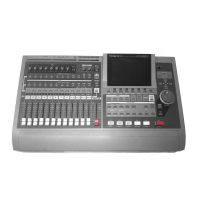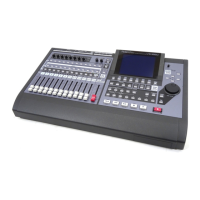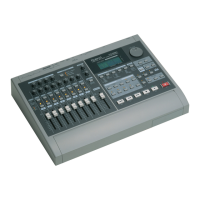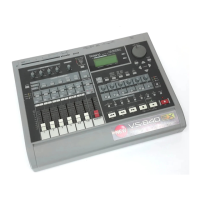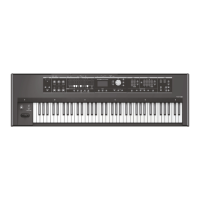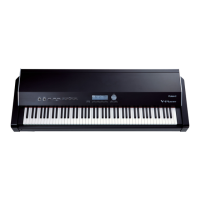Synchronization with the VS-1680 as
the Reference (Master)
When you are having the VS-1680 act to control the
MIDI sequencer, use the following procedure.
1. Connect the VS-1680 and the MIDI sequencer as
shown below.
fig.08-02(vs_mtc->seq.eps)
2. Press [PLAY (DISPLAY)].
3. Hold down [SHIFT] and press [F5 (SYSTEM)].
The System menu icon appears in the display. If the
System menu icon does not appear, then press [F6
(EXIT)].
4. Press [F4 (MIDI)]. If “MIDI” does not appear in
[F4], first press [PAGE] until “MIDI” is displayed,
then press [F4 (MIDI)].
5. Press [ ], [ ], [ ], and [ ] to move the
cursor to “MIDI Thru,” and rotate the
TIME/VALUE dial.
MIDI Thru (MIDI Thru Switch)
This selects the function of the MIDI OUT/THRU con-
nector. For now, select “Out.”
Out: The connector transmits MIDI messages from
the VS-1680. Select this when you want to trans-
mit metronome Note messages or mixer para-
meter settings (control change messages or
exclusive messages).
Thru: MIDI messages received at the MIDI IN connec-
tor will be retransmitted from the connector
without change.
Chapter 8 Use with MIDI Devices
129
Chapter 8
Drop Frame and Non-Drop Frame
There are two types of time code used by NTSC
format video cassette recorders, drop, in which
the time code is not continuous, and non-drop,
which features continuous time code. In drop,
which is used for NTSC color video format, the
first two frames of every minute are dropped,
except for those at ten-minute intervals.
fig.08-01(df/ndf.eps)
In most video and audio production, since for-
mats with continuous frames are easier to deal
with, non-drop is generally used. In contrast, in
situations such as in broadcast, where the time
code must match actual clock time, drop is used.

